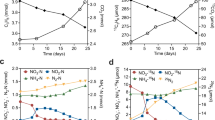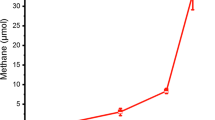Abstract
Biological formation of methane is the terminal process of biomass degradation in aquatic habitats where oxygen, nitrate, ferric iron and sulphate have been depleted as electron acceptors. The pathway leading from dead biomass to methane through the metabolism of anaerobic bacteria and archaea is well understood for easily degradable biomolecules such as carbohydrates, proteins and lipids1,2. However, little is known about the organic compounds that lead to methane in old anoxic sediments where easily degradable biomolecules are no longer available. One class of naturally formed long-lived compounds in such sediments is the saturated hydrocarbons (alkanes)3,4,5. Alkanes are usually considered to be inert in the absence of oxygen, nitrate or sulphate6, and the analysis of alkane patterns is often used for biogeochemical characterization of sediments7,8. However, alkanes might be consumed in anoxic sediments below the zone of sulphate reduction9,10, but the underlying process has not been elucidated. Here we used enrichment cultures to show that the biological conversion of long-chain alkanes to the simplest hydrocarbon, methane, is possible under strictly anoxic conditions.


Similar content being viewed by others
References
Ferry,J. G. Methanogenesis (Chapman & Hall, New York, 1993).
Schink,B. Energetics of syntrophic cooperation in methanogenic degradation. Microbiol. Mol. Biol. Rev. 61, 262–280 (1997).
Birch,L. & Bachofen,R. in Biotechnology Vol. 6b (ed. Rehm, H.-J.) 71–99 (VCH, Weinheim, 1988).
Blumer,M. Guillard,R. & Chase,T. Hydrocarbons of marine phytoplankton. Mar. Biol. 8, 183–189 (1971).
Tissot,B. P. & Welte,D. H. Petroleum Formation and Occurrence (Springer, Berlin, 1984).
Heider,J., Spormann,A. M., Beller,H. R. & Widdel,F. Anaerobic bacterial metabolism of hydrocarbons. FEMS Microbiol. Rev. 22, 459–473 (1999).
Eglinton,G. Hydrocarbons and fatty acids in living organisms and recent and ancient sediments. Adv. Org. Geochem. 31, 1–24 (1968).
Simoneit,B. R. T. Biomarker geochemistry of black shales from Cretaceous oceans—an overview. Mar. Geol. 70, 9–41 (1986).
Giger,W., Schaffner,C. & Wakeham,S. G. Aliphatic and olefinic hydrocarbons in recent sediments of Greifensee, Switzerland. Geochim. Cosmochim. Acta 44, 119–129 (1980).
Wersin,P., Höhener,P., Giovanoli,R. & Stumm,W. Early diagenetic influence on iron transformations in a freshwater lake sediment. Chem. Geol. 90l, 233–252 (1991).
Rozanova,E. P., Savvichev,A. S., Miller,Y. M. & Ivanov,M. V. Microbial processes in a West Siberian oil field flooded with waters containing a complex of organic compounds. Microbiology 66, 718–725 (1997).
Ludwig,W. et al. Bacterial phylogeny based on comparative sequence analysis. Electrophoresis 19, 554–568 (1998).
Widdel,F. & Bak,F. in The Prokaryotes (eds Balows, A., Trüper, H. G., Dworkin, M., Harder, W. & Schleifer, K.-H.) 3352–3392 (Springer, New York, 1992).
Muller,F. M. On methane fermentation of higher alkanes. Antonie van Leeuwenhoek 23, 269–384 (1957).
Schink,B. Degradation of unsaturated hydrocarbons by methanogenic enrichment cultures. FEMS Microbiol. Ecol. 31, 69–77 (1985).
Harder,J. & Foss,S. Anaerobic formation of the aromatic hydrocarbon p-cymene from monoterpenes by methanogenic enrichment cultures. Geomicrobiol. J. (in the press).
Lovley,D. R. & Chapelle,F. H. Deep subsurface microbial processes. Rev. Geophys. 33, 365–381 (1995).
Beier,J. A., Wakeham,S. G., Pilskaln,C. H. & Honjo,S. Enrichment in saturated compounds of Black Sea interfacial sediment. Nature 351, 642–644 (1991).
Parkes,R. J. et al. Deep bacterial biosphere in Pacific Ocean sediments. Nature 371, 410–413 (1994).
Scott,A. R., Kaiser,W. R. & Ayers, W. D. Jr Thermogenic and secondary biogenic gases, San Juan Basin, Colorado and New Mexico—implications for coalbed gas producibility. Am. Assoc. Pet. Geol. Bull. 78, 1186–1209 (1994).
Martini,A. M., Budai,J. M., Walter,L. M. & Schoell,M. Microbial generation of economic accumulations of methane within a shallow organic-rich shale. Nature 383, 155–158 (1996).
Rowe,D. & Muehlenbachs,A. Low-temperature thermal generation of hydrocarbon gases in shallow shales. Nature 398, 61–63 (1999).
Seiler,W., Giehl,H. & Roggendorf,P. Detection of carbon monoxide and hydrogen by conversion of mercury oxide to mercury vapor. Atmos. Technol. 12, 40–45 (1980).
Albert,D. B. & Martens,C. S. Determination of low-molecular-weight organic acid concentrations in seawater and pore-water samples via HPLC. Mar. Chem. 56, 27–37 (1997).
Hayes,J. M., Freeman,K. H., Popp,B. N. & Hoham,C. H. Compound-specific isotope analyses: a novel tool for reconstruction of ancient biogeochemical processes. Org. Geochem. 16, 1115–1128 (1990).
Strunk,O. & Ludwig,W. in http://www.mikro.biologie.tu-muenchen.de (Department of Microbiology, Technische Univ. München, Munich, Germany, 1998).
Dean,J. A. Lange's Handbook of Chemistry (McGraw-Hill, New York, 1992).
Lide,D. R. Handbook of Chemistry and Physics (CRC, Boca Raton, 1998).
Dojka,M. A., Hugenholtz,P., Haack,S. K. & Pace,N. R. Microbial diversity in a hydrocarbon- and chlorinated-solvent-contaminated aquifer undergoing intrinsic bioremediation. Appl. Environ. Microbiol. 64, 3869–3877 (1998).
Acknowledgements
We thank C. Garms, University of Hamburg, for synthesis of labelled hexadecane. We thank J. Oesselmann and A. Hilkert at Finnigan-MAT, Bremen, for providing the IRM-GC-MS, and N. Finke, Max Planck Institute, Bremen, for fatty-acid analysis. This study was supported by the Max-Planck-Gesellschaft and the Fonds der Chemischen Industrie.
Author information
Authors and Affiliations
Corresponding author
Rights and permissions
About this article
Cite this article
Zengler, K., Richnow, H., Rosselló-Mora, R. et al. Methane formation from long-chain alkanes by anaerobic microorganisms. Nature 401, 266–269 (1999). https://doi.org/10.1038/45777
Received:
Accepted:
Issue Date:
DOI: https://doi.org/10.1038/45777
- Springer Nature Limited
This article is cited by
-
Non-syntrophic methanogenic hydrocarbon degradation by an archaeal species
Nature (2022)
-
A microbe that uses crude oil to make methane
Nature (2022)
-
Characteristics of the Archaeal Communities in Petroleum Hydrocarbon-Contaminated Groundwater
Water, Air, & Soil Pollution (2022)
-
Bacterial and archaeal diversity in oil fields and reservoirs and their potential role in hydrocarbon recovery and bioprospecting
Environmental Science and Pollution Research (2021)
-
A review on microbial diversity and genetic markers involved in methanogenic degradation of hydrocarbons: futuristic prospects of biofuel recovery from contaminated regions
Environmental Science and Pollution Research (2021)





